Economics Report: Australian Economy Analysis, Challenges and Exports
VerifiedAdded on 2020/10/23
|9
|2628
|436
Report
AI Summary
This report provides an in-depth analysis of the Australian economy, covering its current state, performance, and key sectors such as agriculture and mining. It examines the economic growth, GDP, and employment figures, highlighting the importance of various sectors. The report identifies major economic problems faced by Australia, including unemployment and financial challenges like the cost of living, and proposes potential solutions. It also explores export products and services, specifically focusing on the role of port cities like Brisbane in facilitating trade. The report concludes by summarizing the main findings and recommendations for addressing the economic challenges and promoting growth.
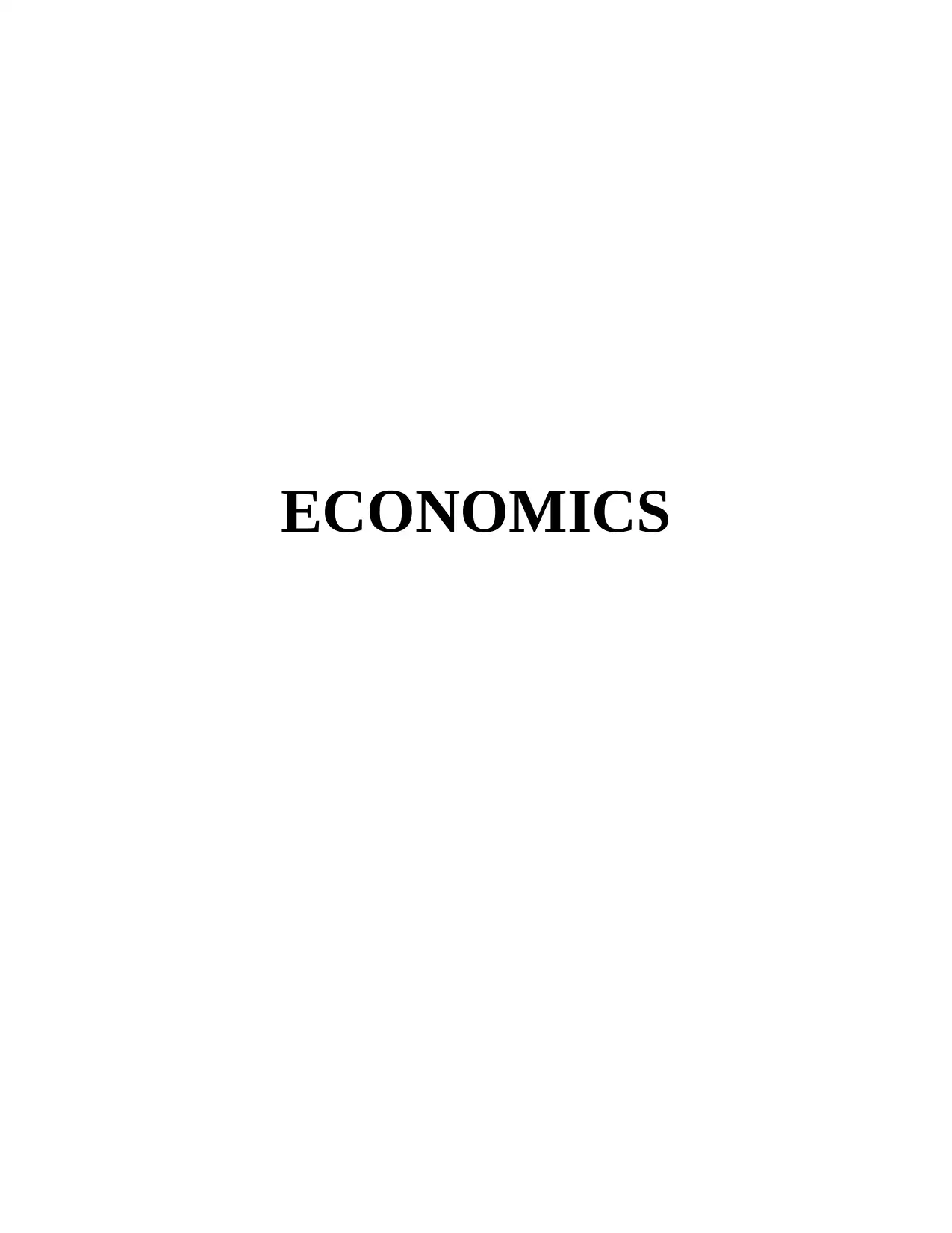
ECONOMICS
Paraphrase This Document
Need a fresh take? Get an instant paraphrase of this document with our AI Paraphraser
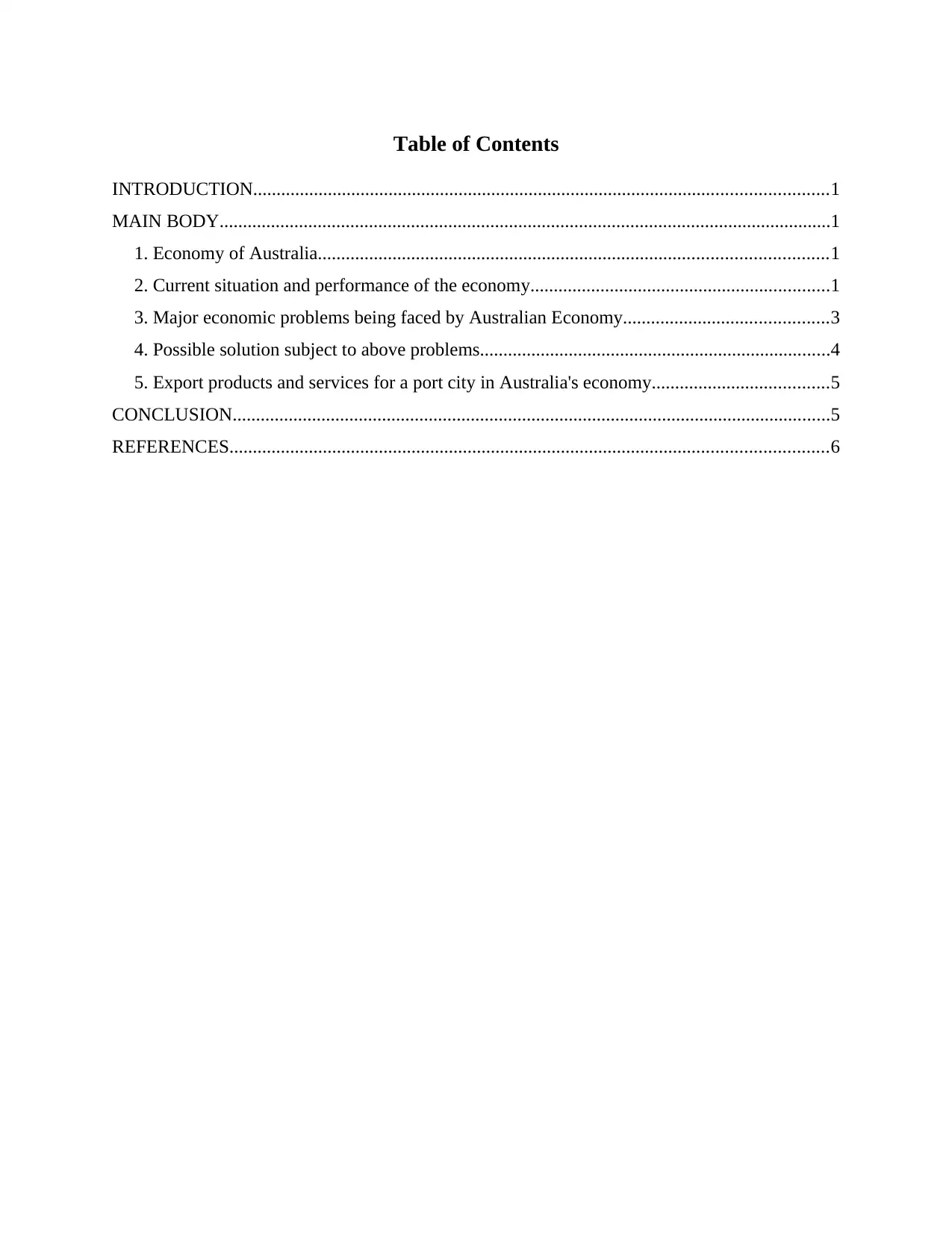
Table of Contents
INTRODUCTION...........................................................................................................................1
MAIN BODY...................................................................................................................................1
1. Economy of Australia.............................................................................................................1
2. Current situation and performance of the economy................................................................1
3. Major economic problems being faced by Australian Economy............................................3
4. Possible solution subject to above problems...........................................................................4
5. Export products and services for a port city in Australia's economy......................................5
CONCLUSION................................................................................................................................5
REFERENCES................................................................................................................................6
INTRODUCTION...........................................................................................................................1
MAIN BODY...................................................................................................................................1
1. Economy of Australia.............................................................................................................1
2. Current situation and performance of the economy................................................................1
3. Major economic problems being faced by Australian Economy............................................3
4. Possible solution subject to above problems...........................................................................4
5. Export products and services for a port city in Australia's economy......................................5
CONCLUSION................................................................................................................................5
REFERENCES................................................................................................................................6
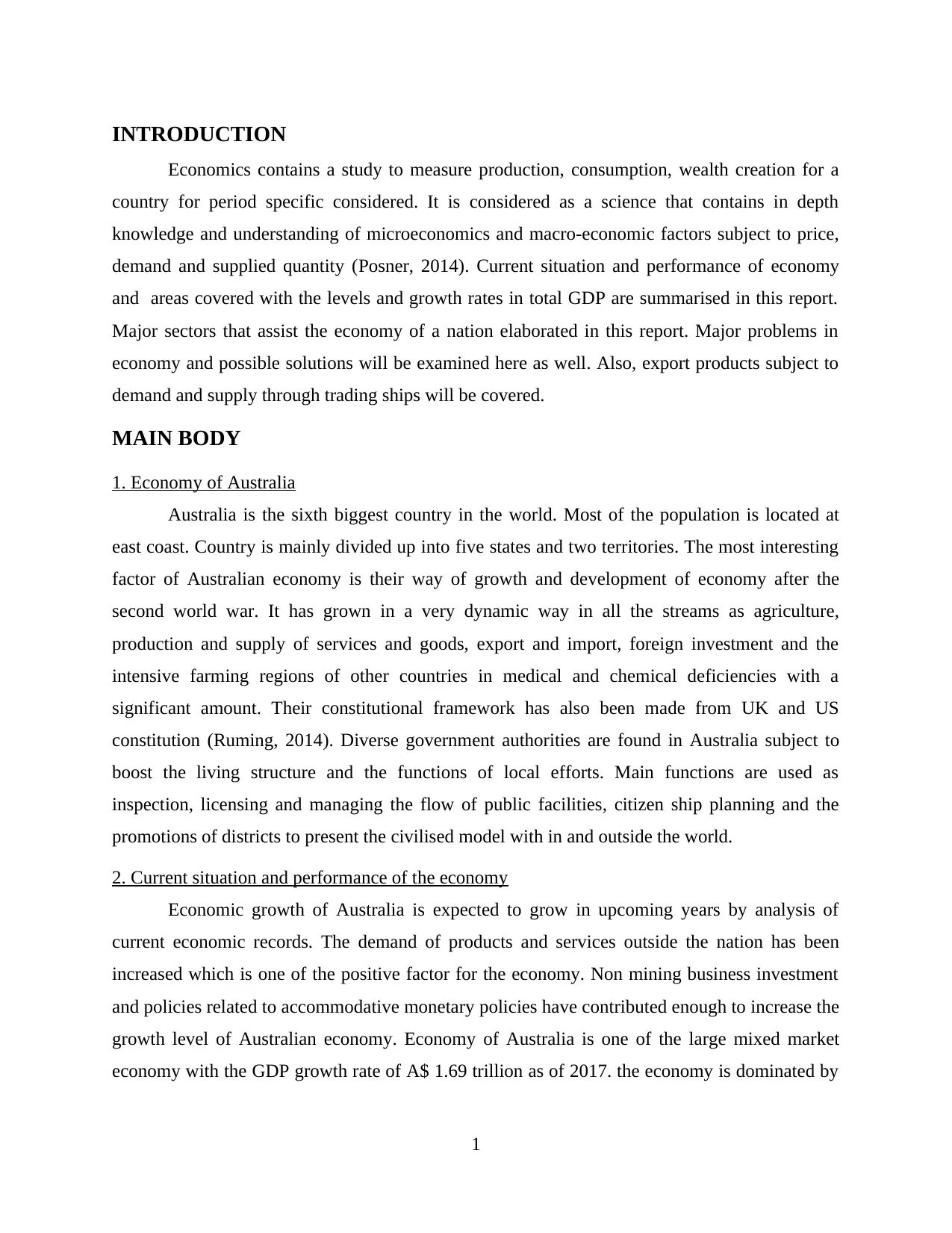
INTRODUCTION
Economics contains a study to measure production, consumption, wealth creation for a
country for period specific considered. It is considered as a science that contains in depth
knowledge and understanding of microeconomics and macro-economic factors subject to price,
demand and supplied quantity (Posner, 2014). Current situation and performance of economy
and areas covered with the levels and growth rates in total GDP are summarised in this report.
Major sectors that assist the economy of a nation elaborated in this report. Major problems in
economy and possible solutions will be examined here as well. Also, export products subject to
demand and supply through trading ships will be covered.
MAIN BODY
1. Economy of Australia
Australia is the sixth biggest country in the world. Most of the population is located at
east coast. Country is mainly divided up into five states and two territories. The most interesting
factor of Australian economy is their way of growth and development of economy after the
second world war. It has grown in a very dynamic way in all the streams as agriculture,
production and supply of services and goods, export and import, foreign investment and the
intensive farming regions of other countries in medical and chemical deficiencies with a
significant amount. Their constitutional framework has also been made from UK and US
constitution (Ruming, 2014). Diverse government authorities are found in Australia subject to
boost the living structure and the functions of local efforts. Main functions are used as
inspection, licensing and managing the flow of public facilities, citizen ship planning and the
promotions of districts to present the civilised model with in and outside the world.
2. Current situation and performance of the economy
Economic growth of Australia is expected to grow in upcoming years by analysis of
current economic records. The demand of products and services outside the nation has been
increased which is one of the positive factor for the economy. Non mining business investment
and policies related to accommodative monetary policies have contributed enough to increase the
growth level of Australian economy. Economy of Australia is one of the large mixed market
economy with the GDP growth rate of A$ 1.69 trillion as of 2017. the economy is dominated by
1
Economics contains a study to measure production, consumption, wealth creation for a
country for period specific considered. It is considered as a science that contains in depth
knowledge and understanding of microeconomics and macro-economic factors subject to price,
demand and supplied quantity (Posner, 2014). Current situation and performance of economy
and areas covered with the levels and growth rates in total GDP are summarised in this report.
Major sectors that assist the economy of a nation elaborated in this report. Major problems in
economy and possible solutions will be examined here as well. Also, export products subject to
demand and supply through trading ships will be covered.
MAIN BODY
1. Economy of Australia
Australia is the sixth biggest country in the world. Most of the population is located at
east coast. Country is mainly divided up into five states and two territories. The most interesting
factor of Australian economy is their way of growth and development of economy after the
second world war. It has grown in a very dynamic way in all the streams as agriculture,
production and supply of services and goods, export and import, foreign investment and the
intensive farming regions of other countries in medical and chemical deficiencies with a
significant amount. Their constitutional framework has also been made from UK and US
constitution (Ruming, 2014). Diverse government authorities are found in Australia subject to
boost the living structure and the functions of local efforts. Main functions are used as
inspection, licensing and managing the flow of public facilities, citizen ship planning and the
promotions of districts to present the civilised model with in and outside the world.
2. Current situation and performance of the economy
Economic growth of Australia is expected to grow in upcoming years by analysis of
current economic records. The demand of products and services outside the nation has been
increased which is one of the positive factor for the economy. Non mining business investment
and policies related to accommodative monetary policies have contributed enough to increase the
growth level of Australian economy. Economy of Australia is one of the large mixed market
economy with the GDP growth rate of A$ 1.69 trillion as of 2017. the economy is dominated by
1
⊘ This is a preview!⊘
Do you want full access?
Subscribe today to unlock all pages.

Trusted by 1+ million students worldwide
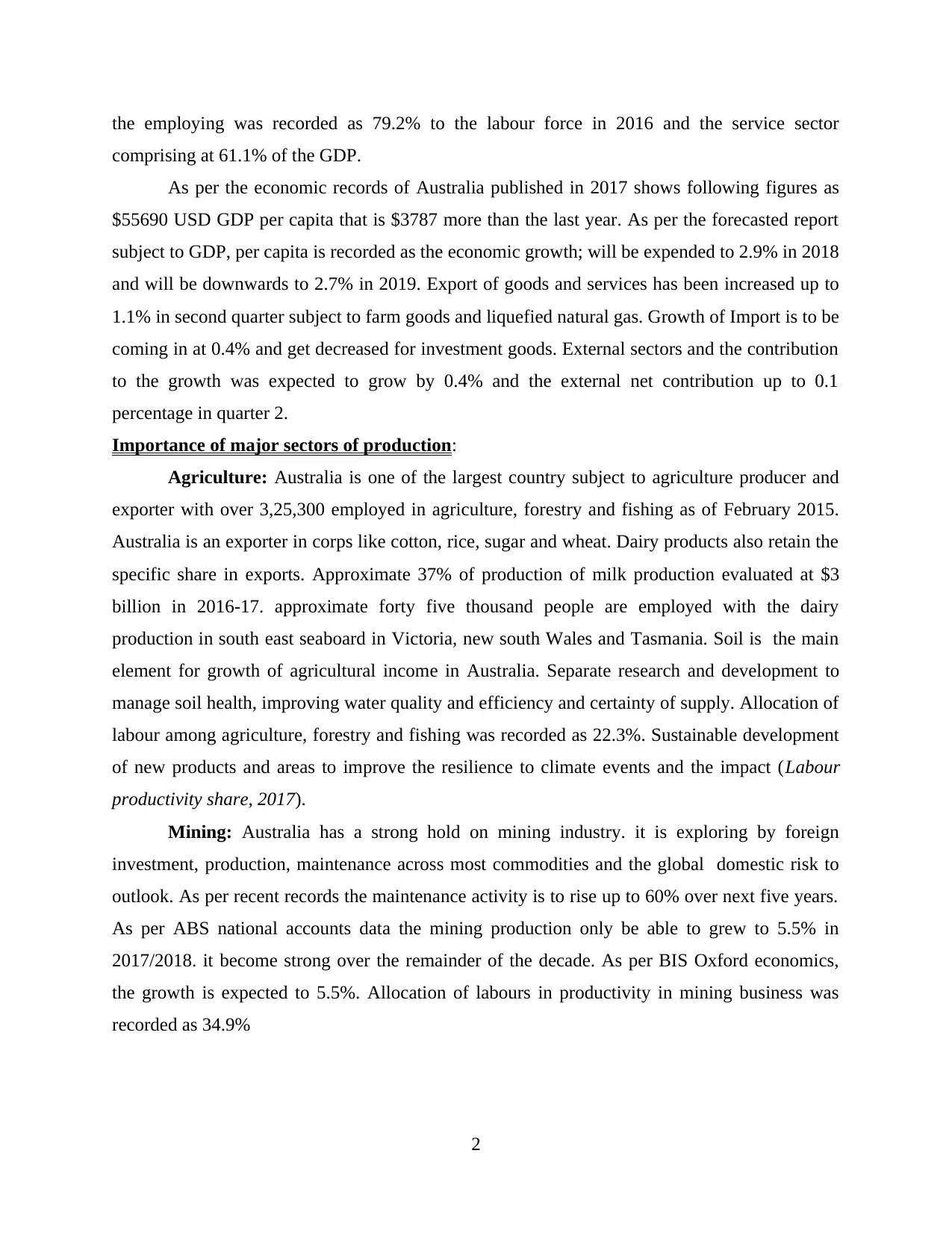
the employing was recorded as 79.2% to the labour force in 2016 and the service sector
comprising at 61.1% of the GDP.
As per the economic records of Australia published in 2017 shows following figures as
$55690 USD GDP per capita that is $3787 more than the last year. As per the forecasted report
subject to GDP, per capita is recorded as the economic growth; will be expended to 2.9% in 2018
and will be downwards to 2.7% in 2019. Export of goods and services has been increased up to
1.1% in second quarter subject to farm goods and liquefied natural gas. Growth of Import is to be
coming in at 0.4% and get decreased for investment goods. External sectors and the contribution
to the growth was expected to grow by 0.4% and the external net contribution up to 0.1
percentage in quarter 2.
Importance of major sectors of production:
Agriculture: Australia is one of the largest country subject to agriculture producer and
exporter with over 3,25,300 employed in agriculture, forestry and fishing as of February 2015.
Australia is an exporter in corps like cotton, rice, sugar and wheat. Dairy products also retain the
specific share in exports. Approximate 37% of production of milk production evaluated at $3
billion in 2016-17. approximate forty five thousand people are employed with the dairy
production in south east seaboard in Victoria, new south Wales and Tasmania. Soil is the main
element for growth of agricultural income in Australia. Separate research and development to
manage soil health, improving water quality and efficiency and certainty of supply. Allocation of
labour among agriculture, forestry and fishing was recorded as 22.3%. Sustainable development
of new products and areas to improve the resilience to climate events and the impact (Labour
productivity share, 2017).
Mining: Australia has a strong hold on mining industry. it is exploring by foreign
investment, production, maintenance across most commodities and the global domestic risk to
outlook. As per recent records the maintenance activity is to rise up to 60% over next five years.
As per ABS national accounts data the mining production only be able to grew to 5.5% in
2017/2018. it become strong over the remainder of the decade. As per BIS Oxford economics,
the growth is expected to 5.5%. Allocation of labours in productivity in mining business was
recorded as 34.9%
2
comprising at 61.1% of the GDP.
As per the economic records of Australia published in 2017 shows following figures as
$55690 USD GDP per capita that is $3787 more than the last year. As per the forecasted report
subject to GDP, per capita is recorded as the economic growth; will be expended to 2.9% in 2018
and will be downwards to 2.7% in 2019. Export of goods and services has been increased up to
1.1% in second quarter subject to farm goods and liquefied natural gas. Growth of Import is to be
coming in at 0.4% and get decreased for investment goods. External sectors and the contribution
to the growth was expected to grow by 0.4% and the external net contribution up to 0.1
percentage in quarter 2.
Importance of major sectors of production:
Agriculture: Australia is one of the largest country subject to agriculture producer and
exporter with over 3,25,300 employed in agriculture, forestry and fishing as of February 2015.
Australia is an exporter in corps like cotton, rice, sugar and wheat. Dairy products also retain the
specific share in exports. Approximate 37% of production of milk production evaluated at $3
billion in 2016-17. approximate forty five thousand people are employed with the dairy
production in south east seaboard in Victoria, new south Wales and Tasmania. Soil is the main
element for growth of agricultural income in Australia. Separate research and development to
manage soil health, improving water quality and efficiency and certainty of supply. Allocation of
labour among agriculture, forestry and fishing was recorded as 22.3%. Sustainable development
of new products and areas to improve the resilience to climate events and the impact (Labour
productivity share, 2017).
Mining: Australia has a strong hold on mining industry. it is exploring by foreign
investment, production, maintenance across most commodities and the global domestic risk to
outlook. As per recent records the maintenance activity is to rise up to 60% over next five years.
As per ABS national accounts data the mining production only be able to grew to 5.5% in
2017/2018. it become strong over the remainder of the decade. As per BIS Oxford economics,
the growth is expected to 5.5%. Allocation of labours in productivity in mining business was
recorded as 34.9%
2
Paraphrase This Document
Need a fresh take? Get an instant paraphrase of this document with our AI Paraphraser
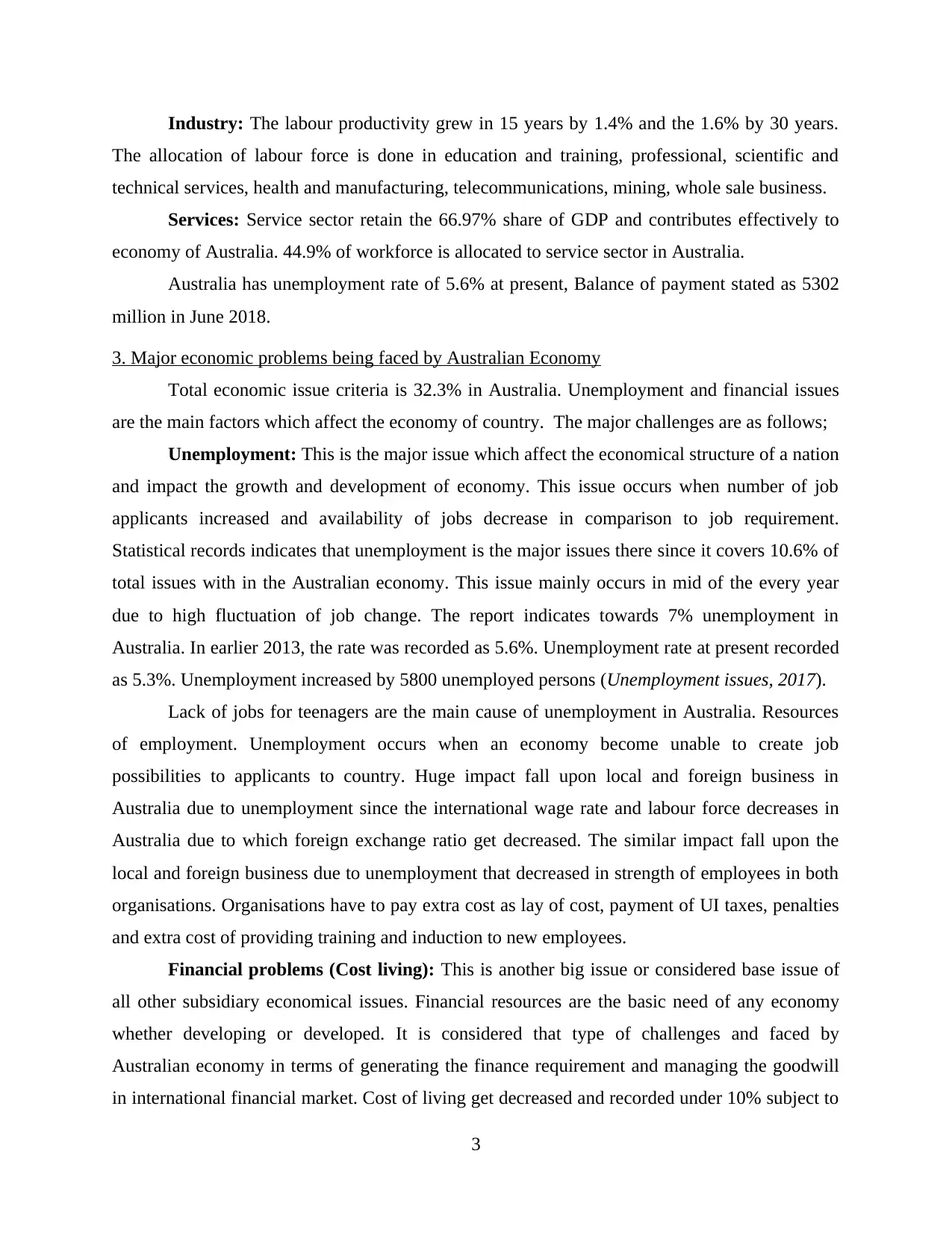
Industry: The labour productivity grew in 15 years by 1.4% and the 1.6% by 30 years.
The allocation of labour force is done in education and training, professional, scientific and
technical services, health and manufacturing, telecommunications, mining, whole sale business.
Services: Service sector retain the 66.97% share of GDP and contributes effectively to
economy of Australia. 44.9% of workforce is allocated to service sector in Australia.
Australia has unemployment rate of 5.6% at present, Balance of payment stated as 5302
million in June 2018.
3. Major economic problems being faced by Australian Economy
Total economic issue criteria is 32.3% in Australia. Unemployment and financial issues
are the main factors which affect the economy of country. The major challenges are as follows;
Unemployment: This is the major issue which affect the economical structure of a nation
and impact the growth and development of economy. This issue occurs when number of job
applicants increased and availability of jobs decrease in comparison to job requirement.
Statistical records indicates that unemployment is the major issues there since it covers 10.6% of
total issues with in the Australian economy. This issue mainly occurs in mid of the every year
due to high fluctuation of job change. The report indicates towards 7% unemployment in
Australia. In earlier 2013, the rate was recorded as 5.6%. Unemployment rate at present recorded
as 5.3%. Unemployment increased by 5800 unemployed persons (Unemployment issues, 2017).
Lack of jobs for teenagers are the main cause of unemployment in Australia. Resources
of employment. Unemployment occurs when an economy become unable to create job
possibilities to applicants to country. Huge impact fall upon local and foreign business in
Australia due to unemployment since the international wage rate and labour force decreases in
Australia due to which foreign exchange ratio get decreased. The similar impact fall upon the
local and foreign business due to unemployment that decreased in strength of employees in both
organisations. Organisations have to pay extra cost as lay of cost, payment of UI taxes, penalties
and extra cost of providing training and induction to new employees.
Financial problems (Cost living): This is another big issue or considered base issue of
all other subsidiary economical issues. Financial resources are the basic need of any economy
whether developing or developed. It is considered that type of challenges and faced by
Australian economy in terms of generating the finance requirement and managing the goodwill
in international financial market. Cost of living get decreased and recorded under 10% subject to
3
The allocation of labour force is done in education and training, professional, scientific and
technical services, health and manufacturing, telecommunications, mining, whole sale business.
Services: Service sector retain the 66.97% share of GDP and contributes effectively to
economy of Australia. 44.9% of workforce is allocated to service sector in Australia.
Australia has unemployment rate of 5.6% at present, Balance of payment stated as 5302
million in June 2018.
3. Major economic problems being faced by Australian Economy
Total economic issue criteria is 32.3% in Australia. Unemployment and financial issues
are the main factors which affect the economy of country. The major challenges are as follows;
Unemployment: This is the major issue which affect the economical structure of a nation
and impact the growth and development of economy. This issue occurs when number of job
applicants increased and availability of jobs decrease in comparison to job requirement.
Statistical records indicates that unemployment is the major issues there since it covers 10.6% of
total issues with in the Australian economy. This issue mainly occurs in mid of the every year
due to high fluctuation of job change. The report indicates towards 7% unemployment in
Australia. In earlier 2013, the rate was recorded as 5.6%. Unemployment rate at present recorded
as 5.3%. Unemployment increased by 5800 unemployed persons (Unemployment issues, 2017).
Lack of jobs for teenagers are the main cause of unemployment in Australia. Resources
of employment. Unemployment occurs when an economy become unable to create job
possibilities to applicants to country. Huge impact fall upon local and foreign business in
Australia due to unemployment since the international wage rate and labour force decreases in
Australia due to which foreign exchange ratio get decreased. The similar impact fall upon the
local and foreign business due to unemployment that decreased in strength of employees in both
organisations. Organisations have to pay extra cost as lay of cost, payment of UI taxes, penalties
and extra cost of providing training and induction to new employees.
Financial problems (Cost living): This is another big issue or considered base issue of
all other subsidiary economical issues. Financial resources are the basic need of any economy
whether developing or developed. It is considered that type of challenges and faced by
Australian economy in terms of generating the finance requirement and managing the goodwill
in international financial market. Cost of living get decreased and recorded under 10% subject to
3
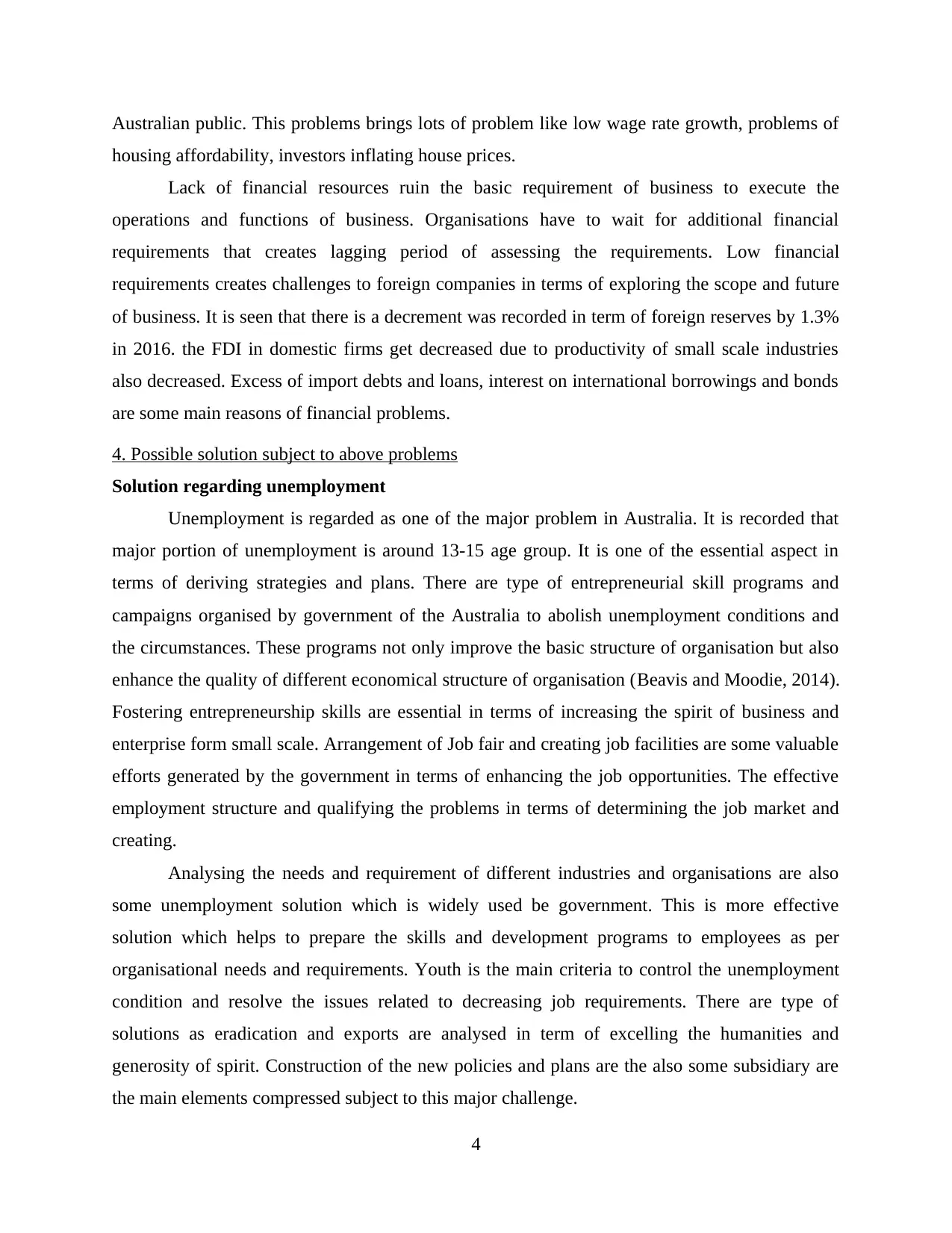
Australian public. This problems brings lots of problem like low wage rate growth, problems of
housing affordability, investors inflating house prices.
Lack of financial resources ruin the basic requirement of business to execute the
operations and functions of business. Organisations have to wait for additional financial
requirements that creates lagging period of assessing the requirements. Low financial
requirements creates challenges to foreign companies in terms of exploring the scope and future
of business. It is seen that there is a decrement was recorded in term of foreign reserves by 1.3%
in 2016. the FDI in domestic firms get decreased due to productivity of small scale industries
also decreased. Excess of import debts and loans, interest on international borrowings and bonds
are some main reasons of financial problems.
4. Possible solution subject to above problems
Solution regarding unemployment
Unemployment is regarded as one of the major problem in Australia. It is recorded that
major portion of unemployment is around 13-15 age group. It is one of the essential aspect in
terms of deriving strategies and plans. There are type of entrepreneurial skill programs and
campaigns organised by government of the Australia to abolish unemployment conditions and
the circumstances. These programs not only improve the basic structure of organisation but also
enhance the quality of different economical structure of organisation (Beavis and Moodie, 2014).
Fostering entrepreneurship skills are essential in terms of increasing the spirit of business and
enterprise form small scale. Arrangement of Job fair and creating job facilities are some valuable
efforts generated by the government in terms of enhancing the job opportunities. The effective
employment structure and qualifying the problems in terms of determining the job market and
creating.
Analysing the needs and requirement of different industries and organisations are also
some unemployment solution which is widely used be government. This is more effective
solution which helps to prepare the skills and development programs to employees as per
organisational needs and requirements. Youth is the main criteria to control the unemployment
condition and resolve the issues related to decreasing job requirements. There are type of
solutions as eradication and exports are analysed in term of excelling the humanities and
generosity of spirit. Construction of the new policies and plans are the also some subsidiary are
the main elements compressed subject to this major challenge.
4
housing affordability, investors inflating house prices.
Lack of financial resources ruin the basic requirement of business to execute the
operations and functions of business. Organisations have to wait for additional financial
requirements that creates lagging period of assessing the requirements. Low financial
requirements creates challenges to foreign companies in terms of exploring the scope and future
of business. It is seen that there is a decrement was recorded in term of foreign reserves by 1.3%
in 2016. the FDI in domestic firms get decreased due to productivity of small scale industries
also decreased. Excess of import debts and loans, interest on international borrowings and bonds
are some main reasons of financial problems.
4. Possible solution subject to above problems
Solution regarding unemployment
Unemployment is regarded as one of the major problem in Australia. It is recorded that
major portion of unemployment is around 13-15 age group. It is one of the essential aspect in
terms of deriving strategies and plans. There are type of entrepreneurial skill programs and
campaigns organised by government of the Australia to abolish unemployment conditions and
the circumstances. These programs not only improve the basic structure of organisation but also
enhance the quality of different economical structure of organisation (Beavis and Moodie, 2014).
Fostering entrepreneurship skills are essential in terms of increasing the spirit of business and
enterprise form small scale. Arrangement of Job fair and creating job facilities are some valuable
efforts generated by the government in terms of enhancing the job opportunities. The effective
employment structure and qualifying the problems in terms of determining the job market and
creating.
Analysing the needs and requirement of different industries and organisations are also
some unemployment solution which is widely used be government. This is more effective
solution which helps to prepare the skills and development programs to employees as per
organisational needs and requirements. Youth is the main criteria to control the unemployment
condition and resolve the issues related to decreasing job requirements. There are type of
solutions as eradication and exports are analysed in term of excelling the humanities and
generosity of spirit. Construction of the new policies and plans are the also some subsidiary are
the main elements compressed subject to this major challenge.
4
⊘ This is a preview!⊘
Do you want full access?
Subscribe today to unlock all pages.

Trusted by 1+ million students worldwide

Solutions regarding financial challenge
Financial challenges are also some challenging factors which created problems in growth
and development of economy. Following steps are taken in respect of financial challenges.
Which are as follows
The economy of Australia is more focused around managing and exploring the financial
structure to meet the export and import requirements.
GDP growth are the main elements covered to overcome financial crisis. There are
opportunities to improve the financial structure of Australia economy in terms of
enhancing foreign exchange reserves.
It is required to determine the volatility of financial resources for long term and short
term objectives. Various type of financial needs as fulfilling limited period cash
requirement for payment of labour and expenses are considered while preparing the
policies related to financial changes and streams.
Adaptation with the best options of borrowing financial sources to fulfil the financial
requirement of business. Australia is the country with wide areas for farming and
developing the industries in economy. The prices are required to summarised with more
significant and synchronised manner.
During the financial crisis the financial challenge was at high level and simulated at $42
billion package. It was delivered in the net investment difference to overcome the challenge in
separate way. Main response is to globalise the financial crisis and creates the guidelines to
improve the structure (Caputi and et. al, 2015).
5. Export products and services for a port city in Australia's economy
Australia is one of the developed economy which deals in various products and services.
There are type of cities authorised in terms of exporting goods and services through trading
ships. Brisbane, Fremantle, Melbourne city, Carins, Gladstone and Portland are some authorised
in terms of exporting goods though trading ship. Brisbane port city is the most common city of
exporting goods and services. The core export products are define follows;
Iron ores and concentrates: These are the main products which are exported from
Australia worldwide. The export of the Iron ores, and concentrates were recorded as $49.3
billion with the change of 24.8%. The change was found increased in term of coal, solid, fuels
5
Financial challenges are also some challenging factors which created problems in growth
and development of economy. Following steps are taken in respect of financial challenges.
Which are as follows
The economy of Australia is more focused around managing and exploring the financial
structure to meet the export and import requirements.
GDP growth are the main elements covered to overcome financial crisis. There are
opportunities to improve the financial structure of Australia economy in terms of
enhancing foreign exchange reserves.
It is required to determine the volatility of financial resources for long term and short
term objectives. Various type of financial needs as fulfilling limited period cash
requirement for payment of labour and expenses are considered while preparing the
policies related to financial changes and streams.
Adaptation with the best options of borrowing financial sources to fulfil the financial
requirement of business. Australia is the country with wide areas for farming and
developing the industries in economy. The prices are required to summarised with more
significant and synchronised manner.
During the financial crisis the financial challenge was at high level and simulated at $42
billion package. It was delivered in the net investment difference to overcome the challenge in
separate way. Main response is to globalise the financial crisis and creates the guidelines to
improve the structure (Caputi and et. al, 2015).
5. Export products and services for a port city in Australia's economy
Australia is one of the developed economy which deals in various products and services.
There are type of cities authorised in terms of exporting goods and services through trading
ships. Brisbane, Fremantle, Melbourne city, Carins, Gladstone and Portland are some authorised
in terms of exporting goods though trading ship. Brisbane port city is the most common city of
exporting goods and services. The core export products are define follows;
Iron ores and concentrates: These are the main products which are exported from
Australia worldwide. The export of the Iron ores, and concentrates were recorded as $49.3
billion with the change of 24.8%. The change was found increased in term of coal, solid, fuels
5
Paraphrase This Document
Need a fresh take? Get an instant paraphrase of this document with our AI Paraphraser
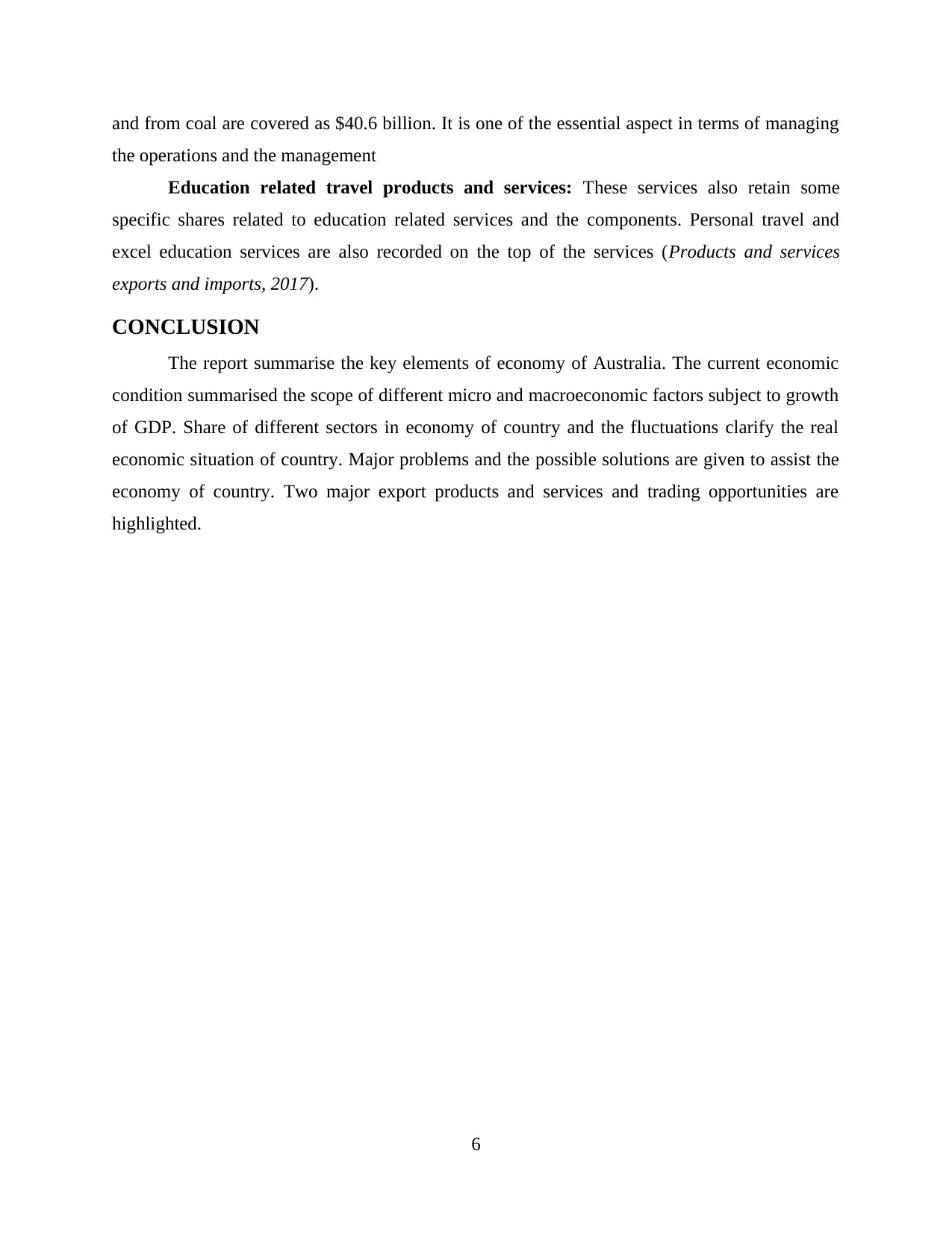
and from coal are covered as $40.6 billion. It is one of the essential aspect in terms of managing
the operations and the management
Education related travel products and services: These services also retain some
specific shares related to education related services and the components. Personal travel and
excel education services are also recorded on the top of the services (Products and services
exports and imports, 2017).
CONCLUSION
The report summarise the key elements of economy of Australia. The current economic
condition summarised the scope of different micro and macroeconomic factors subject to growth
of GDP. Share of different sectors in economy of country and the fluctuations clarify the real
economic situation of country. Major problems and the possible solutions are given to assist the
economy of country. Two major export products and services and trading opportunities are
highlighted.
6
the operations and the management
Education related travel products and services: These services also retain some
specific shares related to education related services and the components. Personal travel and
excel education services are also recorded on the top of the services (Products and services
exports and imports, 2017).
CONCLUSION
The report summarise the key elements of economy of Australia. The current economic
condition summarised the scope of different micro and macroeconomic factors subject to growth
of GDP. Share of different sectors in economy of country and the fluctuations clarify the real
economic situation of country. Major problems and the possible solutions are given to assist the
economy of country. Two major export products and services and trading opportunities are
highlighted.
6
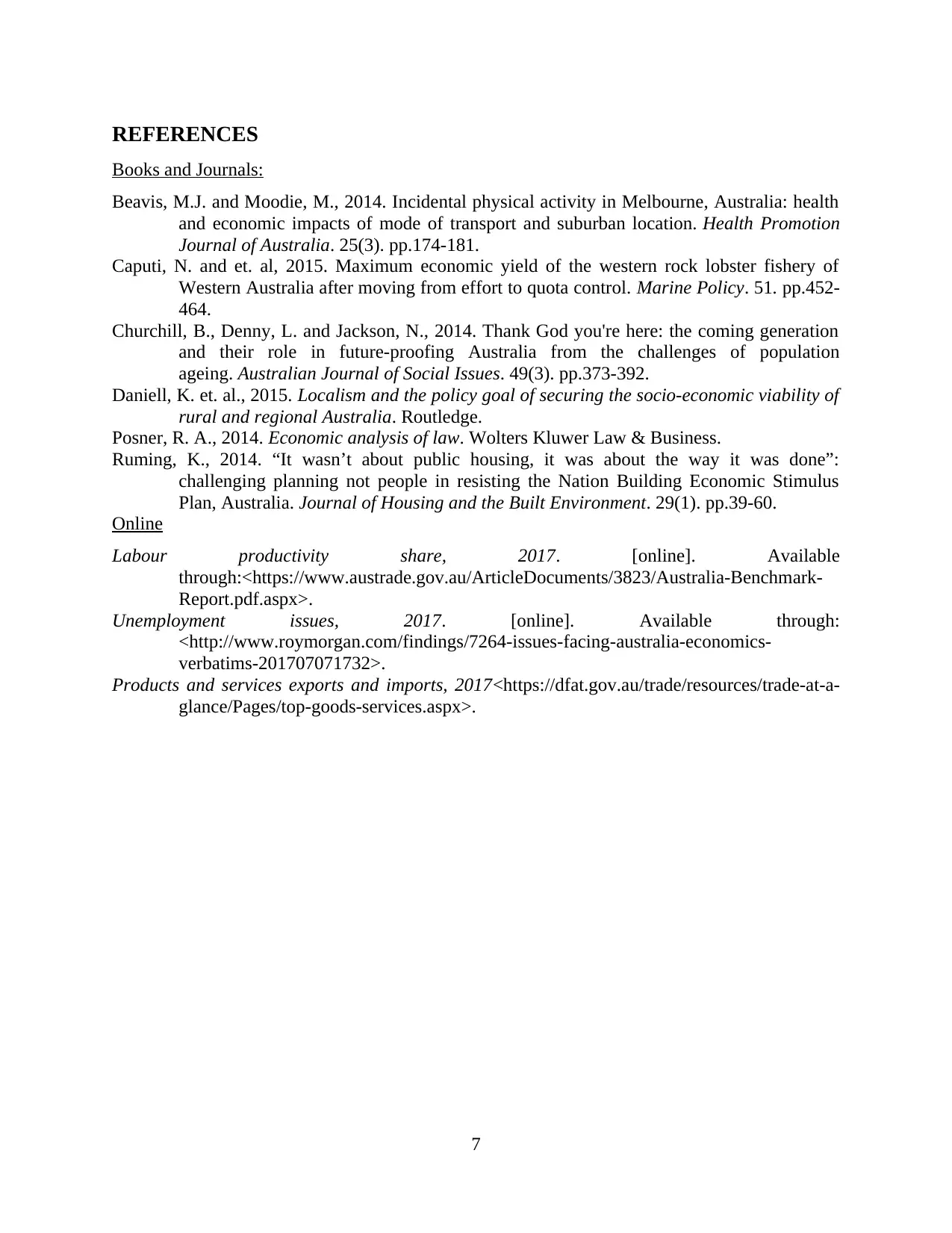
REFERENCES
Books and Journals:
Beavis, M.J. and Moodie, M., 2014. Incidental physical activity in Melbourne, Australia: health
and economic impacts of mode of transport and suburban location. Health Promotion
Journal of Australia. 25(3). pp.174-181.
Caputi, N. and et. al, 2015. Maximum economic yield of the western rock lobster fishery of
Western Australia after moving from effort to quota control. Marine Policy. 51. pp.452-
464.
Churchill, B., Denny, L. and Jackson, N., 2014. Thank God you're here: the coming generation
and their role in future‐proofing Australia from the challenges of population
ageing. Australian Journal of Social Issues. 49(3). pp.373-392.
Daniell, K. et. al., 2015. Localism and the policy goal of securing the socio-economic viability of
rural and regional Australia. Routledge.
Posner, R. A., 2014. Economic analysis of law. Wolters Kluwer Law & Business.
Ruming, K., 2014. “It wasn’t about public housing, it was about the way it was done”:
challenging planning not people in resisting the Nation Building Economic Stimulus
Plan, Australia. Journal of Housing and the Built Environment. 29(1). pp.39-60.
Online
Labour productivity share, 2017. [online]. Available
through:<https://www.austrade.gov.au/ArticleDocuments/3823/Australia-Benchmark-
Report.pdf.aspx>.
Unemployment issues, 2017. [online]. Available through:
<http://www.roymorgan.com/findings/7264-issues-facing-australia-economics-
verbatims-201707071732>.
Products and services exports and imports, 2017<https://dfat.gov.au/trade/resources/trade-at-a-
glance/Pages/top-goods-services.aspx>.
7
Books and Journals:
Beavis, M.J. and Moodie, M., 2014. Incidental physical activity in Melbourne, Australia: health
and economic impacts of mode of transport and suburban location. Health Promotion
Journal of Australia. 25(3). pp.174-181.
Caputi, N. and et. al, 2015. Maximum economic yield of the western rock lobster fishery of
Western Australia after moving from effort to quota control. Marine Policy. 51. pp.452-
464.
Churchill, B., Denny, L. and Jackson, N., 2014. Thank God you're here: the coming generation
and their role in future‐proofing Australia from the challenges of population
ageing. Australian Journal of Social Issues. 49(3). pp.373-392.
Daniell, K. et. al., 2015. Localism and the policy goal of securing the socio-economic viability of
rural and regional Australia. Routledge.
Posner, R. A., 2014. Economic analysis of law. Wolters Kluwer Law & Business.
Ruming, K., 2014. “It wasn’t about public housing, it was about the way it was done”:
challenging planning not people in resisting the Nation Building Economic Stimulus
Plan, Australia. Journal of Housing and the Built Environment. 29(1). pp.39-60.
Online
Labour productivity share, 2017. [online]. Available
through:<https://www.austrade.gov.au/ArticleDocuments/3823/Australia-Benchmark-
Report.pdf.aspx>.
Unemployment issues, 2017. [online]. Available through:
<http://www.roymorgan.com/findings/7264-issues-facing-australia-economics-
verbatims-201707071732>.
Products and services exports and imports, 2017<https://dfat.gov.au/trade/resources/trade-at-a-
glance/Pages/top-goods-services.aspx>.
7
⊘ This is a preview!⊘
Do you want full access?
Subscribe today to unlock all pages.

Trusted by 1+ million students worldwide
1 out of 9
Related Documents
Your All-in-One AI-Powered Toolkit for Academic Success.
+13062052269
info@desklib.com
Available 24*7 on WhatsApp / Email
![[object Object]](/_next/static/media/star-bottom.7253800d.svg)
Unlock your academic potential
Copyright © 2020–2025 A2Z Services. All Rights Reserved. Developed and managed by ZUCOL.




